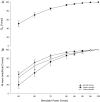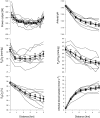Arterial oxygenation influences central motor output and exercise performance via effects on peripheral locomotor muscle fatigue in humans
- PMID: 16793898
- PMCID: PMC1995675
- DOI: 10.1113/jphysiol.2006.113936
Arterial oxygenation influences central motor output and exercise performance via effects on peripheral locomotor muscle fatigue in humans
Abstract
Changing arterial oxygen content (C(aO(2))) has a highly sensitive influence on the rate of peripheral locomotor muscle fatigue development. We examined the effects of C(aO(2)) on exercise performance and its interaction with peripheral quadriceps fatigue. Eight trained males performed four 5 km cycling time trials (power output voluntarily adjustable) at four levels of C(aO(2)) (17.6-24.4 ml O(2) dl(-1)), induced by variations in inspired O(2) fraction (0.15-1.0). Peripheral quadriceps fatigue was assessed via changes in force output pre- versus post-exercise in response to supra-maximal magnetic femoral nerve stimulation (DeltaQ(tw); 1-100 Hz). Central neural drive during the time trials was estimated via quadriceps electromyogram. Increased C(aO(2)) from hypoxia to hyperoxia resulted in parallel increases in central neural output (43%) and power output (30%) during cycling and improved time trial performance (12%); however, the magnitude of DeltaQ(tw) (-33 to -35%) induced by the exercise was not different among the four time trials (P > 0.2). These effects of C(aO(2)) on time trial performance and DeltaQ(tw) were reproducible (coefficient of variation = 1-6%) over repeated trials at each F(IO(2)) on separate days. In the same subjects, changing C(aO(2)) also affected performance time to exhaustion at a fixed work rate, but similarly there was no effect of Delta C(aO(2)) on peripheral fatigue. Based on these results, we hypothesize that the effect of C(aO(2)) on locomotor muscle power output and exercise performance time is determined to a significant extent by the regulation of central motor output to the working muscle in order that peripheral muscle fatigue does not exceed a critical threshold.
Figures







Comment in
-
The rate of fatigue accumulation as a sensed variable.J Physiol. 2006 Sep 15;575(Pt 3):688-9. doi: 10.1113/jphysiol.2006.116087. Epub 2006 Jul 13. J Physiol. 2006. PMID: 16840512 Free PMC article. No abstract available.
-
Arterial oxygenation, central motor output and exercise performance in humans.J Physiol. 2007 Dec 15;585(Pt 3):919-21; author reply 923-4. doi: 10.1113/jphysiol.2007.145110. Epub 2007 Oct 25. J Physiol. 2007. PMID: 17962324 Free PMC article. No abstract available.
References
-
- Adams RP, Welch HG. Oxygen uptake, acid-base status, and performance with varied inspired oxygen fractions. J Appl Physiol. 1980;49:863–868. - PubMed
-
- Amann M, Romer LM, Pegelow DF, Jacques AJ, Hess CJ, Dempsey JA. The effects of arterial oxygen content upon peripheral locomotor muscle fatigue. J Appl Physiol. 2006;101:119–127. - PubMed
-
- Amann M, Subudhi A, Foster C. Influence of testing protocol on ventilatory thresholds and cycling performance. Med Sci Sports Exerc. 2004;36:613–622. - PubMed
-
- Arbogast S, Vassilakopoulos T, Darques JL, Duvauchelle JB, Jammes Y. Influence of oxygen supply on activation of group IV muscle afferents after low-frequency muscle stimulation. Muscle Nerve. 2000;23:1187–1193. - PubMed
Publication types
MeSH terms
Substances
Grants and funding
LinkOut - more resources
Full Text Sources
Medical

